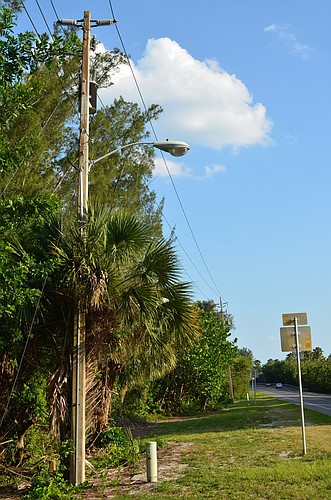- April 28, 2024
-
-
Loading

Loading

Let there be light.
The Longboat Key Town Commission’s on-again, off-again debate about burying the town’s power lines has flickered back to life after three 5-2 votes have previously ended the discussion in the past month.
All seven commissioners unanimously agreed at a special meeting Monday at Town Hall to further investigate the possibility of burying power lines, along with town cable and phone utilities that are strung along the poles.
Previously, only Commissioners Lynn Larson and Pat Zunz pushed for more investigation into Florida Power & Light Co.’s proposal to bury the power lines at an approximate $10 million cost.
Town staff proposed the concept in May because it’s ramping up a hardening project this summer that will install larger, wider 41-foot high poles (current poles are 39 feet) along the island’s thoroughfare that will be able to withstand hurricane-force winds.
It appears an email effort Country Club Shores resident Bob Gault made to commissioners this past week paid off.
Gault urged commissioners to debate the issue this fall when more of the island’s residents return to the Key, citing the need for more exploration and revealing that other Florida communities have buried utilities recently at cheaper than anticipated costs (see related story, right).
Both Commissioner Lynn Larson and Mayor Jim Brown have also talked to town officials on Florida’s east coast that performed underground utility projects that led them to want to discuss the issue further.
Brown asked for and received unanimous support to discuss the item again at the commission’s July 7 regular meeting, citing the need to possibly hire a consultant to investigate the matter.
Danny Brannon, a principal and consultant with North Palm Beach-based Brannon & Gillespie LLC, has performed conversions in Jupiter Island and Jupiter Inland Colony. Brannon is also working on conversions for the towns of Gulfstream Pompano Beach, Hollywood Beach, Jupiter and Palm Beach.
“These projects can be done through the use of consultants that provide project management, with FPL just performing field supervision,” Brannon said.
Vice Mayor Jack Duncan asked FPL spokeswoman Rae Dowling for more time to consider underground utility options before the company moves forward with the hardening project. On Monday afternoon, Dowling confirmed the company could postpone the project for a year, albeit at a binding estimate cost of $61,966.
Commissioners, though, think they can get FPL to postpone the project without having to pay a cost while they figure out what to do.
Brown said any results of an underground utility study should be presented to the voters for a referendum in March.
Commissioner Terry Gans, who previously urged the commission to move past the issue because the town has more pressing issues, agreed to continue the discussion on one condition.
“If we decide to go further, when the time comes to involve the citizens, it has to be in the context of all of the total financial impacts of the taxpayers,” Gans said. “It can’t be looked at in a vacuum.”
Burying Power Lines
Several communities on Florida’s east coast have recently buried underground utilities. The Longboat Observer reached out to some of those communities this week.
Jupiter Island
Jupiter Island Town Manager Gene Rauth, a former Florida Power & Light Co. regional construction-engineering manager, oversaw a two-year underground utility project for a community of approximately 813 residents.
The $12 million project was completed in 2012, with Jupiter Island residents taking out a bond for $8 million and FPL paying $4 million. Residents are repaying the debt through a .43 millage in ad valorem tax over 20 years, which amounts to an $800,00 annual payment from a $2 billion taxable base.
Rauth said the improved result is fewer power outages and no wires falling after thunderstorms.
Jupiter Island is an 8-mile long island that has more than 1,500 residents during season.
Jupiter Inlet Colony
Jupiter Inlet Colony Administrator Samuel Pruitt and Jupiter Inlet Colony Mayor Dan Comerford oversaw an underground utility effort three years ago.
“Leading up to the project, transformers were blowing constantly from the saltwater air causing corrosion,” Pruitt said. “For the last two years, we’ve had zero outage problems.”
Pruitt also said the community “looks so much better.”
Jupiter Inlet Colony is a barrier island municipality of 237 single-family homes on the southern tip of Jupiter Island.
Residents agreed to pay a non ad valorem assessment on their taxes for 15 years that amounts to $930 to $1,500 per year, per household for 15 years. The town received a bond with a 7% fixed rate loan.
There were several public meetings held before a vote. Comerford said 77% of the homeowners voted and produced a 75% majority vote in favor of the project.
The project was performed for $2.6 million through the negotiation of a consultant and was done under budget. The original cost was $3.2 million.
Palm Beach
In April, Florida Power & Light Co. approached the town of Palm Beach with a similar hardening project that the company wants to perform on Longboat Key.
Palm Beach Deputy Town Manager Tom Bradford said the town is still waiting for ballpark estimates from FPL before it decides to move forward with an underground project. The commission will reconvene in September to discuss the matter.
“There’s a general feeling the town and its citizens don’t want the larger hardened poles and facilities,” Bradford said. “It’s just not aesthetically pleasing.”
Palm Beach is a 12-mile long island with 8,500 full-time residents and up to 20,000 residents in season.
Contact Kurt Schultheis at [email protected]